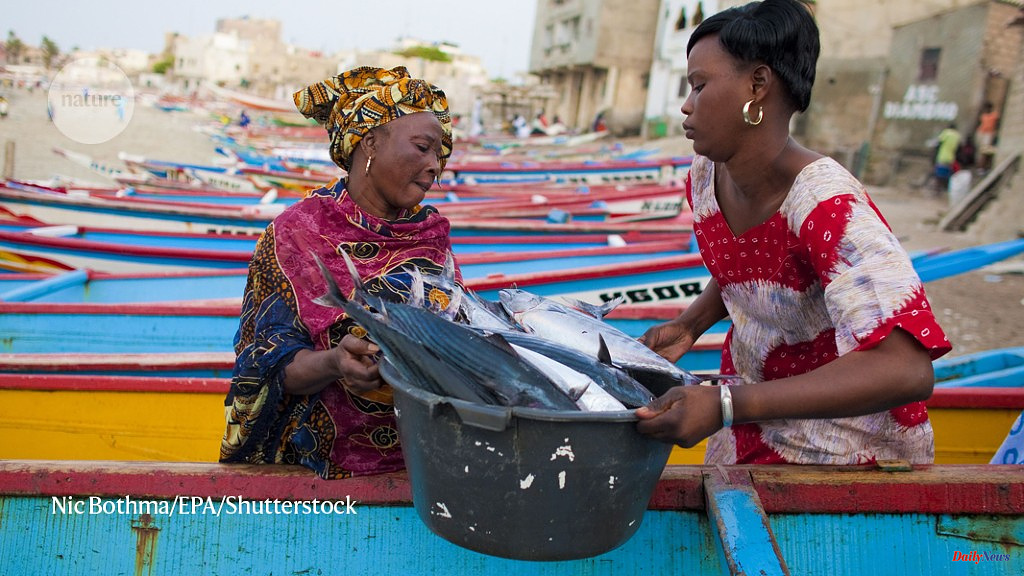Over three billion people depend on the ocean for their livelihood, with most of them living in developing countries. Aquaculture and fisheries are the primary source of animal protein for approximately 17% of the world’s population. Fish contributes 29% to the animal protein intake of least-developed countries; it contributes 19% in other developing countries.
The demand for seafood will rise as the world population grows. Already, fish production has increased by a third in Asia and Africa over the last few decades. Globally, the consumption of fish is expected to increase by 15% by 20302.
Even though ocean ecosystems are being impacted by climate change, overfishing, and other factors, research suggests that sustainable seafood expansion can be achieved to meet future food needs. This approach was promoted internationally by the Blue Food Assessment, a joint initiative of 25 research institutions, and the United Nations Food Systems Summit.
Small-scale fishing is key to success. Small-scale fisheries are more likely to provide food and income directly for those who most need it, and the locals will be motivated to sustain their operations. These fisheries are also incredibly efficient. Nearly all the fish caught by hand-to-mouth fishing fleets is eaten. Around 20% of industrial fleets' fish is wasted due to unwanted by-catch. So while large-scale fishers catch more fish than small-scale ones, smaller-scale fisheries capture a greater proportion of what is actually eaten.
The resources required to grow or survive are rarely available to small fishers. They may lose their advantages or engage the same harmful practices that large commercial fisheries if they grow. Small fisheries can be managed with care and could offer benefits for both livelihoods as well as the environment. This should be a top priority at the UN Ocean Conference in Lisbon.
Here are some suggestions from someone who has spent decades studying food security and policymaking.
Over the past decade, small-scale fishing has gained more recognition. The UN Food and Agriculture Organization (FAO), provided guidelines in 2014 to encourage sustainable small-scale fishing. These guidelines were designed to improve food security and eradicate poverty. The FAO, Duke University, Durham, North Carolina and WorldFish, an international non-profit organization based in Penang (Malaysia), will soon publish a report that summarizes a remarkable initiative to collect case studies, questionnaire results, and data sets in order to give fishers a seat at the policymakers' table. The UN General Assembly declared 2022 as the International Year of Artisanal Fisheries and Aquaculture.
Many countries already have policies to manage their marine ecosystems so that small-scale fishing can be supported. To prevent large-scale industrial fishers from grabbing large catches, Sri Lanka, Indonesia, Malaysia, and Malaysia have all banned trawling within 8 km of the coast. This protects local fishers. Small-scale fisheries are exempted from licensing in countries like Costa Rica. Angola also exempts subsistence fishers and artisanal fishermen from having to pay licensing fees.
This is not enough. Access rights for small-scale fishermen are often not clearly defined, poorly enforced, or unevenly distributed. The borders of exclusive economic zones (EEZs), which are the areas of the coast that belong to a nation, are often not well enforced. Large-scale vessels frequently swoop in to take sea life via bottom trawling. This is something small fishers rarely do. Global fisheries catch is 26% dominated by large-scale bottom-trawlers. More than 99% of this occurs in the EEZs coastal countries6. Foreign vessels can profit from the well-meaning policies that are in place to protect local fishers. A 2018 investigation by London's Environmental Justice Foundation found that 90% of Ghana’s industrial fishing fleet was owned by Chinese, despite Ghanaian laws explicitly prohibiting foreign ownership of its boats. To help small-scale operators, it might be possible to provide clearer definitions of fisher, fishing, and fishing vessel.
Reforms are also needed for government subsidies. According to one estimate, large-scale fishermen receive three-and-a half times as many subsidies as small-scale fishers7. This increases the advantages of large operations in terms vessels and gear, infrastructure (including cold stock), processing capacity, and fuel access. It can encourage overfishing by giving large-scale fishermen more catch capacity. Subventions and other funds should instead be directed to small-scale fishermen to increase their access to markets while preventing them from adopting the bad practices of large-scale operations.
Global fisheries loss and waste is estimated to be between 30% and 35% per year. As smaller businesses expand their markets, this could rise. According to a 2015 Volta Basin Coast study, 65% of fish production losses were due to poor technology and manufacturing practices. The study showed that most fish were not lost due to physical damage, but rather from spoilage. These losses can limit fish sales locally as well as to distant markets.
Private and public investment could be made in cold storage facilities and processing equipment, such as drying, fermentation, pickling, or smoking. Development partners, regional banks and the World Bank provide funding for fishery conservation projects. Some entities also offer microloans for small-scale fisheries. However, these efforts are not coordinated and insufficient.
A promising strategy is to combine international or national funding with contracts for direct feeding programs linked to schools, hospitals, and similar facilities. These arrangements would allow small fisheries to have large, consistent markets as well as storage infrastructure that encourages overfishing.
Another strategy is to pair local fishermen with conservation efforts. Fish entrails and other waste can't be simply thrown in the ocean as fishing operations grow. It is important to ensure that the environment doesn't become contaminated. One option is to fund ecosystem-restoration projects that also benefit local fisheries. Mikoko Pamoja, or Mangroves Together, is a project that restores and preserves degraded mangrove forests in Gazi Bay, Kenya. These trees act as nurseries for young fish. This restoration generates carbon credits that can be sold and also improves the fishery areas in the area.
Because small fisheries have shorter supply chains, consumers could help them by purchasing local. This will allow them to earn more. Ecolabels, which are designed to encourage sustainable fisheries management by certifying that a product has less environmental impact, could be used to help consumers make informed decisions and encourage adoption.
This certification can be costly and difficult to maintain. It also requires monitoring, reporting, compliance and monitoring. Small businesses may be excluded from international markets because certification can distort opportunities. Unintended consequences can also be caused by these programs: Most certification programs focus on sustainability, but pay less attention social responsibility elements like fair access to markets, resources, and wages.
Local governments, funders, and managers could instead implement simple incentive programs to encourage sustainable fishing. Local markets might have a rating system that allows small- and medium-sized entrepreneurs to rate their fisherman. It could also include information about the fishing gear used, the location of the catch, and the freshness of the fish. The rating system could be promoted as a social responsibility concept to inform consumers about the need for sustainable fisheries. Community members could conduct the rating system.
Diverse efforts are required to ensure small fisheries have access to the oceans, boost local consumption and reduce waste. These efforts must be tailored to the local conditions. Although the UN Food Systems Summit 2021 was an 'people's summit, it elevated Indigenous peoples' roles and civil-society organizations, but fishing communities were notably absent.
Few governments adopt an integrated approach when implementing, enforcing and developing policies. Policies governing urban development, for example, don't consider the impacts on fish, oceans, and fishermen. After improvements to the port and construction of a private marina, and hotel, fishers were denied access to traditional public fishing areas along Durban's beachfront in South Africa in the 2000s. After protests and engagement with authorities10, some areas were reclaimed by fishers.
Cooperatives can be a powerful tool for promoting human rights and social justice. They can coordinate fishing activities and share information about weather, sea conditions and fish movement. CoopeSoliDar is a cooperative for small-scale fisheries management in San Jose, Costa Rica. It has been instrumental in strengthening collective action to sustainably use Molluscs, reduce poverty, and increase the participation of young women and girls in community decision-making. The government can provide a legal framework for cooperatives to be established and included in the management of marine resources.
Local communities may also be able to stand up for their rights. A 2004 class action was filed by 5,000 South African artisanal fishermen against a policy that they claimed did not allow them access to food or fishing rights. In 2007, the court ruled in favor of the group. The resulting legal framework gave small-scale fishers collective fishing rights and recognized community members as bona fide fishermen11.
Small fisheries cannot operate in isolation. The ocean, unlike terrestrial resources, is a vast, global commons that has no clear territorial boundaries. Local fishers are affected by issues such as climate change and ocean acidification. These system interactions are often overlooked when fisheries policies only focus on one seafood stock or one fishing area.
While integrated land management has been part and parcel of the development agenda for decades, integrated marine management is just now emerging. It must include all stakeholders, even small-scale fishermen, in order to work.
An example of this integration is the Seychelles' context-specific strategy. The Seychelles Marine Spatial Plan Initiative was created by communities, funding partners, and the government. It protects 30% of the archipelago’s waters and increases climate resilience. Rising sea levels, warmer temperatures, and rising sea levels pose significant risks to the Seychelles' fisheries, infrastructure, and rich biodiversity.
Local communities contributed to a plan for marine protection in the Coral Triangle region, which includes Indonesia, Malaysia and Papua New Guinea. It also encompasses the Solomon Islands, East Timor, the Philippines and the Solomon Islands. It was possible to better understand how overfishing and taking in too many stock can sustain marine and coastal resources. This also helped to manage these to address climate change, food security, and threats to marine biodiversity. Such cooperation between fishing communities and governments in managing marine protected areas is essential to the preservation of future fish stocks (see go.nature.com/3xvkqxj).
Participation by fishers in UN and local council meetings is essential so they can voice their concerns about fishing access, livelihoods, and the environment. Both organizers and fishers must work together to create empowerment mechanisms that ensure their voices are heard. This includes providing translation services, scheduling meetings at accessible locations, and setting up meeting times. This is not only important for fishers' human rights but also because of the richness of artisanal fisherman's local knowledge.
For example, moves that restrict fishing seasons or areas to ensure biodiversity or stocks recovery should include compensation mechanisms that secure the livelihoods and cooperation of fishers. Fishers can also be helped by social-protection measures like income and food assistance.
Fish that swim in schools are more efficient, can forage better, and are protected against predators. This is true for small-scale fishermen, but it should also apply to international and local communities. A global seafood supply system that is integrated and collaborative in problem solving can be sustainable.












